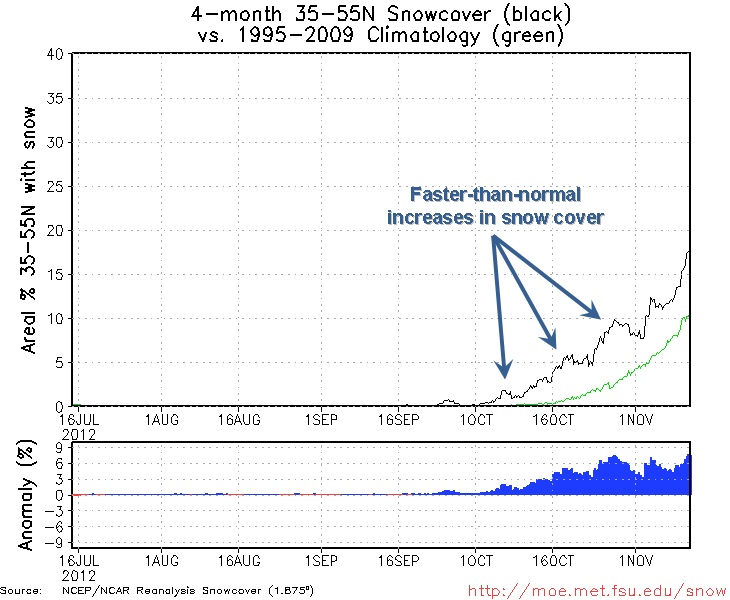Over the past two weeks, we have covered four different winter forecasting techniques, ranging from fun traditions (the woolly worm and farmers’ almanacs) to more robust science (predicting the NAO/AO and ENSO patterns). So what are these methods telling us about the 2012-13 winter?
The Woolly Worm
This year’s woolly worm predictions were made during the 35th Annual Woolly Worm Festival in Banner Elk, held on October 20 and 21. After racing its way to victory, a worm named Lickety Split earned the honor of being the official woolly worm forecaster for the coming winter. According to the festival organizers, Lickety Split’s colored bands indicate a cold and snowy start to winter, turning milder by late January, then finishing in mid-March with a blast of cooler weather and possibly some snow and ice.
Farmers’ Almanacs
Both of the US’s long-running almanacs agree that North Carolina should be in for a cooler-than-normal winter. The Old Farmer’s Almanac is also calling for “below-normal rainfall and near- or above-normal snowfall”, while the Farmers’ Almanac suggests “Wet & Chilly” conditions will prevail across the Southeast US. They also agree on potential hazardous weather in mid-February, with the Old Farmer’s Almanac predicting a snow or ice threat then and the Farmers’ Almanac forecasting a “major coastal storm” between February 12 and 15. We will see whether these forecasts correctly call a cold winter or if they are just full of hot air.
Siberian Snowfall
Eurasian snow cover increased rapidly from early October through the end of the month. October 2012 Eurasian snow cover was the 11th highest total out of the past 45 years. For reference, last year’s October Eurasian snow covered ranked 27th.
This year’s Eurasian snow cover is quite similar to October 2009, which ranked 10th. The winter of 2009-2010 went on to be the sixth coldest on record at the Raleigh-Durham International airport.
According to the research done at Atmospheric and Environmental Research, the rapid increase in Eurasian snow cover this year may portend a predominantly negative Arctic and North Atlantic Oscillation this winter, which would enhance the potential of cold, wintry weather in North Carolina.

El Niño/Southern Oscillation
Earlier this year, computer models suggested El Niño conditions would develop as we headed into winter. However, sea surface temperatures in the equatorial Pacific Ocean have recently cooled rather than warmed, and it now appears that neutral ENSO conditions will prevail through the winter months.
Even with weak El Niño conditions in place the past few months, we haven’t seen the typical signs of an El Niño pattern in the atmosphere, which would include an increase in the number of non-tropical storm systems delivered to the southern US by a stronger subtropical jet stream. Unless something changes, it appears ENSO will not have a significant effect on our weather this winter.
Summary
So what are these forecasting techniques telling us about the upcoming winter? The woolly worm and farmers’ almanacs are betting on cooler weather with some snow to boot. It appears ENSO will have minimal impact on winter conditions, which means that higher frequency patterns such as the Arctic Oscillation (AO) and North Atlantic Oscillation (NAO) will likely be the driving forces behind the weather we receive. A positive-phase AO/NAO would suggest a stretch of milder weather, while a negative phase for these oscillations could herald a cold and possibly snowy period. And a rapid early-season buildup of snowfall in southern Siberia could favor a predominantly negative-phase AO/NAO for the winter.
With all things considered, the confidence in this year’s winter forecast is lower than normal, largely because of the weak ENSO signal. However, it is reasonable to say that the upcoming winter will probably be cooler than last year’s, which was one of the top five warmest on record for most of the state. Without the persistent La Niña pattern in place, as was the case last winter, we could also stand to see a few more chances for wintry weather. Again, though, this will primarily depend on how the AO and NAO patterns set up throughout the season.
For snow lovers disheartened by last year’s fleeting flakes, the coming winter may hold more promise. If we do get snow this winter, just be sure to send a thank you to our friends in Siberia.